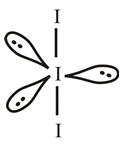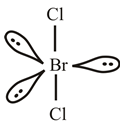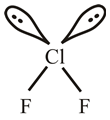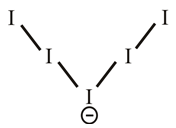
(a)
Interpretation: To draw the lewis dot structure and molecular structure of
Concept introduction:
A lewis dot structure is a diagram that show bonding between the atoms. A lewis dot structure is used to predict the geometry of the molecule.
A lewis dot structure is a two dimensional representation whereas a molecular structure is a three dimensional structure and many of the properties both chemical and physical are dictated by molecular structure.
Molecular geometry is the shape of a molecule predicted by considering only bond pair of electrons
Electron geometry is the shape of a molecule predicted by considering both bond electron pairs and lone pair of electrons.
According to VSEPR theory, the geometry is predicted by the minimizing the repulsions between electron-pairs in the bonds and lone-pairs of electrons. The VSEPR theory is summarized in the given table as,
(a)
Answer to Problem 78GQ
The lewis dot structure of

The molecular structure of

Explanation of Solution
The iodine atom belongs to group
The lewis dot structure of

The molecular structure of
The molecular structure of

(b)
Interpretation: To draw the lewis dot structure and molecular structure of
Concept introduction:
A lewis dot structure is a diagram that show bonding between the atoms. A lewis dot structure is used to predict the geometry of the molecule.
A lewis dot structure is a two dimensional representation whereas a molecular structure is a three dimensional structure and many of the properties both chemical and physical are dictated by molecular structure.
Molecular geometry is the shape of a molecule predicted by considering only bond pair of electrons
Electron geometry is the shape of a molecule predicted by considering both bond electron pairs and lone pair of electrons.
According to VSEPR theory, the geometry is predicted by the minimizing the repulsions between electron-pairs in the bonds and lone-pairs of electrons. The VSEPR theory is summarized in the given table as,
(b)
Answer to Problem 78GQ
The lewis dot structure of

The molecular structure of

Explanation of Solution
The bromine atom belongs to group
The lewis dot structure of

The molecular structure of
The molecular structure of

(c)
Interpretation: To draw the lewis dot structure and molecular structure of
Concept introduction:
A lewis dot structure is a diagram that show bonding between the atoms. A lewis dot structure is used to predict the geometry of the molecule.
A lewis dot structure is a two dimensional representation whereas a molecular structure is a three dimensional structure and many of the properties both chemical and physical are dictated by molecular structure.
Molecular geometry is the shape of a molecule predicted by considering only bond pair of electrons
Electron geometry is the shape of a molecule predicted by considering both bond electron pairs and lone pair of electrons.
According to VSEPR theory, the geometry is predicted by the minimizing the repulsions between electron-pairs in the bonds and lone-pairs of electrons. The VSEPR theory is summarized in the given table as,
(c)
Answer to Problem 78GQ
The lewis dot structure of

The molecular structure of

Explanation of Solution
The flourine atom belongs to group
The lewis dot structure of

The molecular structure of
The molecular geometry of

(d)
Interpretation: To draw the lewis dot structure and molecular structure of
Concept introduction:
A lewis dot structure is a diagram that show bonding between the atoms. A lewis dot structure is used to predict the geometry of the molecule.
A lewis dot structure is a two dimensional representation whereas a molecular structure is a three dimensional structure and many of the properties both chemical and physical are dictated by molecular structure.
Molecular geometry is the shape of a molecule predicted by considering only bond pair of electrons
Electron geometry is the shape of a molecule predicted by considering both bond electron pairs and lone pair of electrons.
According to VSEPR theory, the geometry is predicted by the minimizing the repulsions between electron-pairs in the bonds and lone-pairs of electrons. The VSEPR theory is summarized in the given table as,
(d)
Answer to Problem 78GQ
The lewis dot structure of

The molecular structure of

Explanation of Solution
The iodine atom belongs to group
The lewis dot structure of

The molecular structure of

Want to see more full solutions like this?
Chapter 21 Solutions
Chemistry & Chemical Reactivity
- Determine the change in Gibbs energy, entropy, and enthalpy at 25°C for the battery from which the data in the table were obtained.T (°C) 15 20 25 30 35Eo (mV) 227.13 224.38 221.87 219.37 216.59Data: n = 1, F = 96485 C mol–1arrow_forwardIndicate the correct options.1. The units of the transport number are Siemens per mole.2. The Siemens and the ohm are not equivalent.3. The Van't Hoff factor is dimensionless.4. Molar conductivity does not depend on the electrolyte concentration.arrow_forwardIdeally nonpolarizable electrodes can1. participate as reducers in reactions.2. be formed only with hydrogen.3. participate as oxidizers in reactions.4. form open and closed electrochemical systems.arrow_forward
- Indicate the options for an electrified interface:1. Temperature has no influence on it.2. Not all theories that describe it include a well-defined electrical double layer.3. Under favorable conditions, its differential capacitance can be determined with the help of experimental measurements.4. A component with high electronic conductivity is involved in its formation.arrow_forwardTo describe the structure of the interface, there are theories or models that can be distinguished by:1. calculation of the charge density.2. distribution of ions in the solution.3. experimentally measured potential difference.4. external Helmoltz plane.arrow_forwardIndicate the correct options when referring to Luther's equation:1. It is not always easy to compare its results with experimental results.2. It depends on the number of electrons exchanged in the species involved.3. Its foundation is thermodynamic.4. The values calculated with it do not depend on temperature.arrow_forward
- Indicate which of the unit options correspond to a measurement of current density.1. A s m-22. mC s-1 m-23. Ω m-24. V J-1 m-2arrow_forwardIndicate the options that are true when referring to electrode membranes:1. The Donnan potential, in general, does not always intervene in membranes.2. There are several ways to classify the same membrane.3. Any membrane can be used to determine the pH of a solution.4. Only one solution and one membrane are needed to determine the pH of that solution.arrow_forwardCalculate the maximum volume of carbon dioxide gasarrow_forward
- In galvanic cells, their potential1. can be measured with a potentiometer2. does not depend on the equilibrium constant of the reaction occurring within them3. is only calculated from the normal potentials of the electrodes they comprise4. can sometimes be considered a variation in a potential differencearrow_forwardIf some molecules in an excited state collide with other molecules in a ground state, this process1. can occur in solution and in the gas phase.2. can be treated as a bimolecular process.3. always results in collisional deactivation.4. does not compete with any other process.arrow_forwardRadiation of frequency v is incident on molecules in their ground state. The expected outcome is that1. the molecules do not change their state.2. the molecules transition to an excited state.3. the molecules undergo a secondary process.4. collisional deactivation occurs.arrow_forward
 Chemistry: Principles and PracticeChemistryISBN:9780534420123Author:Daniel L. Reger, Scott R. Goode, David W. Ball, Edward MercerPublisher:Cengage Learning
Chemistry: Principles and PracticeChemistryISBN:9780534420123Author:Daniel L. Reger, Scott R. Goode, David W. Ball, Edward MercerPublisher:Cengage Learning Chemistry: The Molecular ScienceChemistryISBN:9781285199047Author:John W. Moore, Conrad L. StanitskiPublisher:Cengage Learning
Chemistry: The Molecular ScienceChemistryISBN:9781285199047Author:John W. Moore, Conrad L. StanitskiPublisher:Cengage Learning Chemistry for Engineering StudentsChemistryISBN:9781337398909Author:Lawrence S. Brown, Tom HolmePublisher:Cengage Learning
Chemistry for Engineering StudentsChemistryISBN:9781337398909Author:Lawrence S. Brown, Tom HolmePublisher:Cengage Learning Chemistry & Chemical ReactivityChemistryISBN:9781133949640Author:John C. Kotz, Paul M. Treichel, John Townsend, David TreichelPublisher:Cengage Learning
Chemistry & Chemical ReactivityChemistryISBN:9781133949640Author:John C. Kotz, Paul M. Treichel, John Townsend, David TreichelPublisher:Cengage Learning Chemistry by OpenStax (2015-05-04)ChemistryISBN:9781938168390Author:Klaus Theopold, Richard H Langley, Paul Flowers, William R. Robinson, Mark BlaserPublisher:OpenStax
Chemistry by OpenStax (2015-05-04)ChemistryISBN:9781938168390Author:Klaus Theopold, Richard H Langley, Paul Flowers, William R. Robinson, Mark BlaserPublisher:OpenStax




